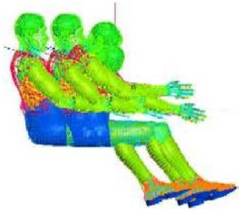|
Validation of human body FE models: Human
Neck (Cervical spine)
THUMS (Total human model for safety) [Watanabe
et al]
is a finite element model of human body developed to study various
injury mechanisms and for use as a substitute for crash test
dummies. The development team of Toyota Central R&D Labs (TCRDL) has
validated different parts of this model against experimental data
available in literature. Neck response data for different impact
conditions is available in Mertz and Patrick,
and McElhaney et.al.
A preliminary validation of the neck model in Thums, against some of
these tests, has been presented by the TCRDL group [Oshita et.al]
but no extensive validation has been reported for the variety of
test conditions reported in literature. Typically, frontal, side and
rear end impacts are of interest and these cause bending, axial as
well as torsional loading on the cervical spine. A computational
model can be expected to validate against multiple BCs and initial
conditions. Therefore, validation of a computational model (THUMS)
in varying test conditions is of significance. Thus the objective of
the current work is to independently investigate the fidelity of the
neck model of THUMS under varying impact conditions.
From the initial seating position
the Thums model has been modified to match the initial position in
the tests. The impact test conditions used in the experiments have
been then recreated in PAMCRASHTM and simulations have
been carried out to validate the neck model. The models and the
material properties have then been iterated and the performance of
the Thums model has been investigated vis-à-vis the experimental
results.
In this paper we have verified the THUMS
cervical spine model against three sets of experimental data
available in literature. The model validates well in some cases but
is found lacking in some others. The reasons for the same have been
discussed and possible directions for improvement have been
suggested. These include better material models for soft tissues,
better muscle model, better failure / rupture models, better contact
interfaces and inclusion of more details in the neck model, to name
a few. We are currently investigating most of these issues and would
have more suggestions in these areas in the months to come.
   
Movements in THUMS
after 0.025, 0.05, 0.075 and 0.092 msec. (Chawla A
et al., 2005)


Final Sitting Position of THUMS
for frontal (Chawla A et al., 2005)
Sled Model using Shell Element
(Chawla A et al.,2005)
 
Initial Position of THUMS (Chawla
A et al., 2005) THUMS with
chest restraint system (Chawla A et al., 2005)
 
 
 
Front, side and Top view of
the neck model prepared for simulating Human cervical spine to
torsion. (Chawla A et al., 2005)
    
Movements
in THUMS after 0 msec, 100 msec, 150 msec, 200 msec and 250 msec
respectively. (Chawla A et al., 2005)
 
Movements in THUMS neck after 0 msec, 100msec,
200 msec and 300 msec respectively.
(Chawla A et al., 2005)

Super imposed view of neck
|